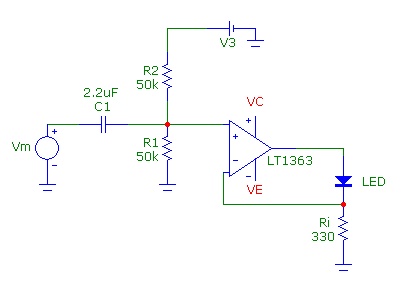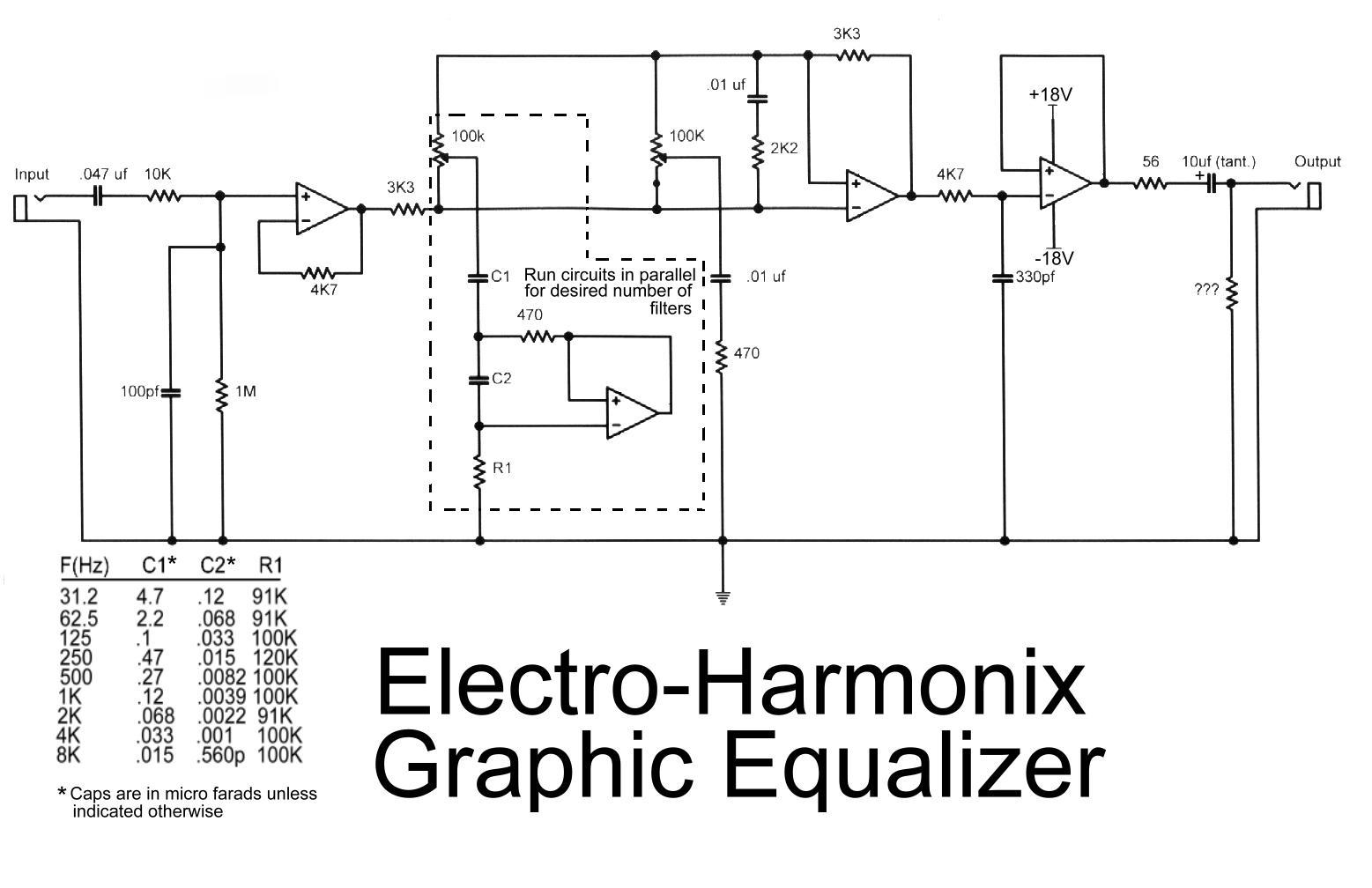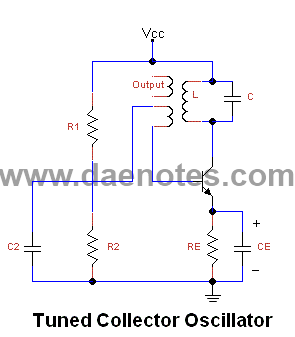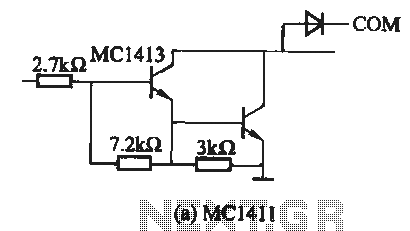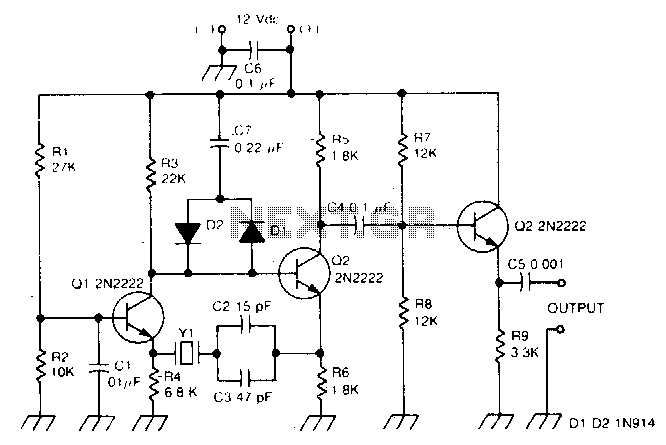
The equivalent circuit and a local oscillator
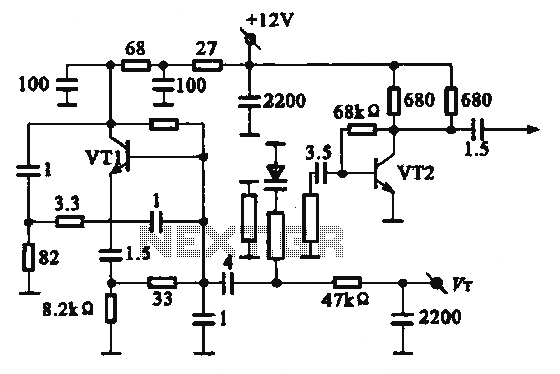
The local oscillator operates at frequencies of 1 GHz or higher, utilizing a common collector circuit, which makes it challenging to generate low-frequency self-oscillation. Typically, the local oscillator signal is passed through a buffer amplifier stage before being applied to the mixer. This mixing action helps minimize the impact on the frequency stability of the local oscillator. The native oscillator, represented in the equivalent circuit, employs a co-collector capacitance feedback oscillator configuration. When the tuning voltage is adjusted, the capacitance of the varactor connected to the oscillator circuit changes, resulting in a variation in the oscillation frequency, thereby enabling channel selection.
The local oscillator circuit is a critical component in radio frequency (RF) applications, particularly in communication systems where frequency stability and precision are paramount. The design utilizes a common collector configuration, often referred to as an emitter follower, which provides high input impedance and low output impedance. This configuration is essential for buffering the oscillator signal before it reaches the mixer, ensuring that the signal integrity is maintained while minimizing loading effects.
The buffer amplifier stage is crucial as it isolates the local oscillator from the mixer, preventing any variations in the mixer load from affecting the oscillator's frequency stability. This isolation is particularly important in high-frequency applications where even minor fluctuations can lead to significant performance degradation.
The co-collector capacitance feedback oscillator circuit is characterized by its ability to maintain oscillation through the use of feedback provided by the collector capacitance. This feedback mechanism is responsible for stabilizing the oscillation frequency and improving the overall performance of the oscillator. The use of a varactor diode in this configuration allows for electronic tuning of the oscillation frequency. The varactor's capacitance varies with the applied tuning voltage, enabling precise control over the frequency of oscillation. This tuning capability is essential for applications such as channel selection in communication systems, where different frequency channels need to be accessed dynamically.
In summary, the local oscillator circuit described is designed for high-frequency applications, employing a common collector configuration and incorporating a buffer amplifier and a co-collector capacitance feedback oscillator. The use of a varactor for tuning enhances the circuit's flexibility and functionality, making it suitable for a range of RF applications.The local oscillator at 1GHz or more to use more common collector circuit, it is not easy to produce low-frequency self-oscillation. Typically the local oscillator signal to go through a buffer amplifier stage impulse applied to the mixer, mixing action to reduce the impact on the local oscillator frequency stability. Native oscillator and the like as shown in the equivalent circuit, are co-collector capacitance feedback oscillator circuit.
When tuning voltage value changes, the capacitor connected to the oscillator circuit varactor amount of change, leading change the oscillation frequency, and thus can achieve channel selection.
The local oscillator circuit is a critical component in radio frequency (RF) applications, particularly in communication systems where frequency stability and precision are paramount. The design utilizes a common collector configuration, often referred to as an emitter follower, which provides high input impedance and low output impedance. This configuration is essential for buffering the oscillator signal before it reaches the mixer, ensuring that the signal integrity is maintained while minimizing loading effects.
The buffer amplifier stage is crucial as it isolates the local oscillator from the mixer, preventing any variations in the mixer load from affecting the oscillator's frequency stability. This isolation is particularly important in high-frequency applications where even minor fluctuations can lead to significant performance degradation.
The co-collector capacitance feedback oscillator circuit is characterized by its ability to maintain oscillation through the use of feedback provided by the collector capacitance. This feedback mechanism is responsible for stabilizing the oscillation frequency and improving the overall performance of the oscillator. The use of a varactor diode in this configuration allows for electronic tuning of the oscillation frequency. The varactor's capacitance varies with the applied tuning voltage, enabling precise control over the frequency of oscillation. This tuning capability is essential for applications such as channel selection in communication systems, where different frequency channels need to be accessed dynamically.
In summary, the local oscillator circuit described is designed for high-frequency applications, employing a common collector configuration and incorporating a buffer amplifier and a co-collector capacitance feedback oscillator. The use of a varactor for tuning enhances the circuit's flexibility and functionality, making it suitable for a range of RF applications.The local oscillator at 1GHz or more to use more common collector circuit, it is not easy to produce low-frequency self-oscillation. Typically the local oscillator signal to go through a buffer amplifier stage impulse applied to the mixer, mixing action to reduce the impact on the local oscillator frequency stability. Native oscillator and the like as shown in the equivalent circuit, are co-collector capacitance feedback oscillator circuit.
When tuning voltage value changes, the capacitor connected to the oscillator circuit varactor amount of change, leading change the oscillation frequency, and thus can achieve channel selection.
